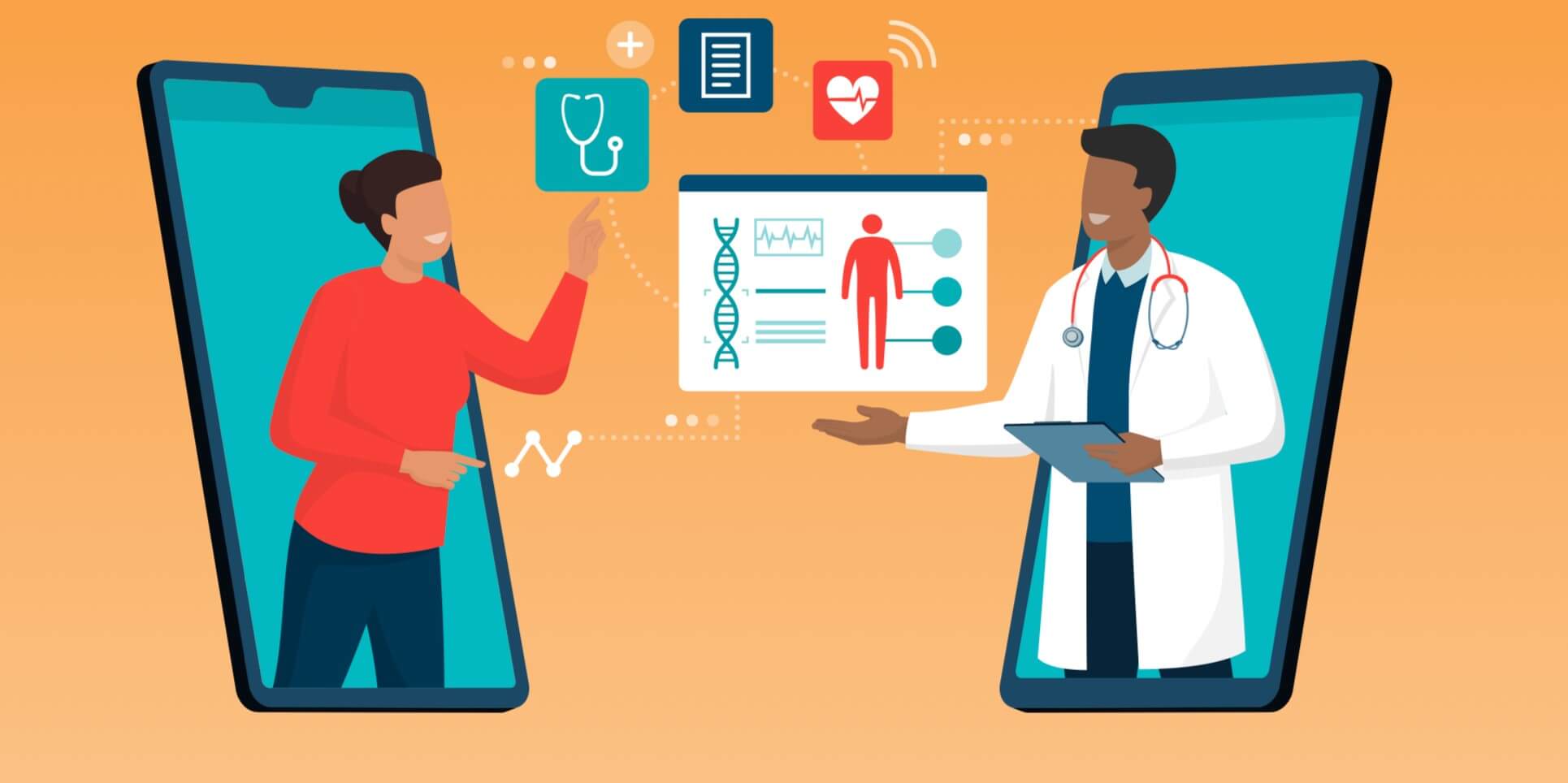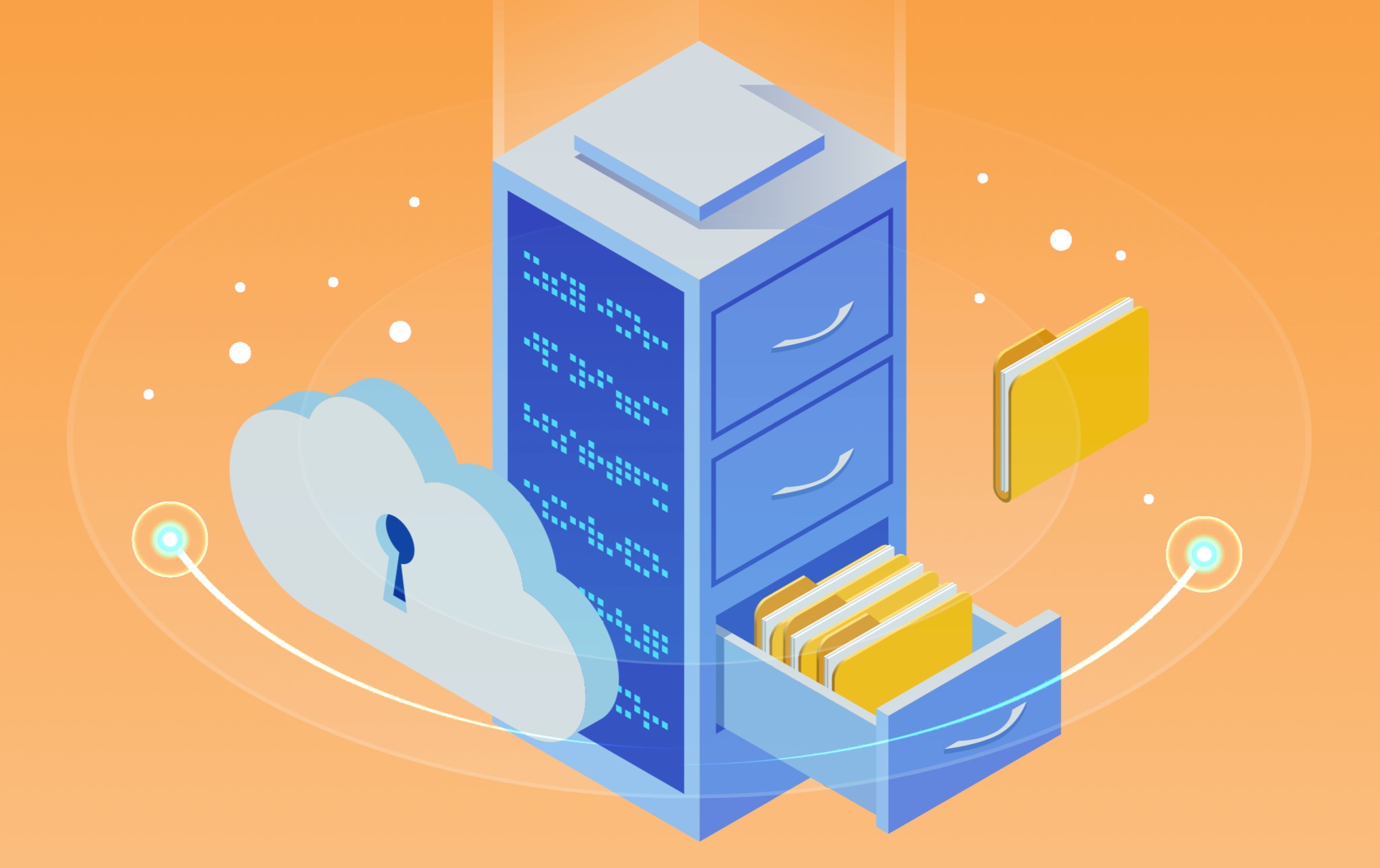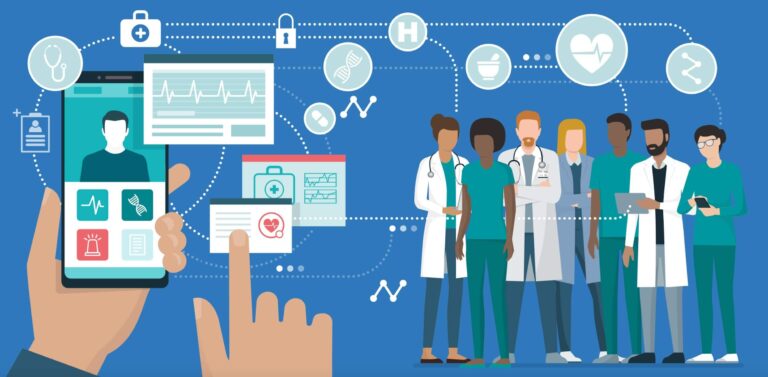It’s a common sight in hospitals and clinics, clinicians rushing to their next appointment with laptops or tablets in their arms, then spending most of their office visits typing your patient data into a slim computer. Long gone are the rows of file cabinets and walls of bulging paper folders, holding your health records. You’ve been digitalized – patient records are now electronic medical records (EMRs or sometimes known as EHRs or electronic health records).

It started nearly 50 years ago…
Keeping records ‘in the cloud’ started in the 1970s and Congress continued to push healthcare organizations to modernize their electronic health records with the Health Information Technology for Economic and Clinical Health (HITECH) Act of 2009. This cloud migration is well underway, so let’s take a look at the good, the bad, and the future of cloud computing in healthcare.
The Good…
Early adopters of cloud-based tools and data sharing powered by patient data are outpacing competitors. They have lowered the cost of care, improved outcomes, and made customer/patient loyalty and satisfaction gains while yielding growth and profitability.
Migrating to the cloud unlocks the potential for health organizations to adapt, incorporate and evolve. With the addition of artificial intelligence (A.I), clinicians are able to be much more agile with caregiver processes like EHR notation and innovation, leveraging AI for routine tasks.
- Innovation is no longer possible with on-premise data solutions. A cloud platform offers seamless remote patient access, intelligent analytics-driven care, and newly-automated back-office processes like coding and collections.
- EHRs lower costs (up 15%) for hardware, software, networking, and IT personnel, while increasing productivity.
- Moving to the cloud = Improved patient engagement + greater transparency. With a patient portal, patients can access their history, future appointments, test results, and prescriptions. It empowers all the stakeholders (Doctors and patients) with accurate data for decision-making.
- Cloud computing is cost-efficient. It runs under a subscription model, so healthcare providers can reduce costs by using the cloud provider’s resources. Large on-premise systems are expensive and complex to deploy and maintain for providers. Cloud core flexibility enables systems to evolve and adapt.
- Compliance data is more secure in the cloud. Healthcare mandates and regulations can be updated and added easily, lending themselves to matching metric-driven reporting requirements.
- Accurate decision-making and treatment. The collection and processing capabilities of cloud computing enhanced analytics can reduce the number of medical errors significantly.
- Artificial Intelligence and Machine Learning (AI, ML) support clinical decisions, for patient treatment and operational efficiency. Cloud computing can also support the transition of artificial intelligence into mainstream healthcare operations and help users manage massive amounts of data.
- Interoperability between connected medical devices and the systems that store patient data has become an increasingly important issue for the future. An accepted standard for communication and data transfer between devices is needed for healthcare systems that are lacking many of the benefits of a connected healthcare environment.
Organizations that expand their cloud capabilities today will be able to effectively adapt to the changing healthcare landscape in the coming years.

The bad (or the factors are preventing healthcare from diving in, head first)…
So, if cloud computing is the way that the world is turning, why is healthcare among those silos that are dragging their feet? Cloud security is important to protect patient privacy, comply with healthcare laws and ensure that only authorized healthcare professionals can access patient data.
Keep in mind, these inconveniences are minor bumps in the road compared to giant leaps of progress the healthcare cloud has brought us…and it’s getting better. But, when healthcare institutions decide to adopt the healthcare cloud, they need to take these common mistakes into account or there will be consequences.

- Not using these solutions to overcome cloud security challenges. The key challenges to cloud network security concerns can be overcome with encryption, two-factor identification, and intelligence.
- Encryption: Encryption changes data into a secure format that only an authorized user with the correct encryption key can access. Data should be encrypted when it is in use, in transit, and at rest to make sure that the data is unreadable if it is lost or stolen.
- Two-factor identification: Requiring a second form of identification like a fingerprint or specialized software token adds an extra layer of security to ensure only authorized users access the healthcare data.
- Security intelligence system: An effective security intelligence system that monitors the logs of all of the cloud servers and firewalls for any unusual activities, can identify and block cyberattacks and malware, and prevent potential data breaches or data loss.
- Security is the most important decision you will make when choosing a networking specialist for your team, cutting corners is not an option.
- Seeing cloud adoption as a project, not a journey. Executing cloud adoption as a series of one-off projects leads to incompatible silos of clouds, vendors, contracts, processes, security gaps, and more. And that can make the whole cloud transformation initiative backfire.
- Underestimating skill requirements and cultural impact. Cloud skills are scarce, and without a detailed plan to attract, hire, and retain top talent, the cloud transformation agenda will slow to a crawl. Equally important, it is easy to underestimate the impact the shift to a cloud computing technology can have on existing employees.
- Lack of understanding of cloud economics. Deploying cloud computing solutions is financially efficient – if you know how to manage the savings levers and take a “design to cost” approach that allows you to optimize consumption, right-size resources, and manage licensing and contractual obligations to your best advantage. It is important to take a detailed look at key financial metrics and how you’ll track them as you create your cloud strategy and execution plan.
Failure to put the right metrics in place to measure success. Some business leaders say they’ll know success when they see it. This approach does not work well in transitions to adopt cloud solutions. Quantifying success metrics and monitoring them carefully leads to better patient outcomes.

And The Future…
The Pandemic – Agent of Change in Cloud-based Healthcare Solutions
Remember the filled beds lining the hallways of hospitals and staff working until they were dead on their feet during the Covid-19 Pandemic? Health systems have had no choice but to transform the care delivery problems that the pandemic brought to the surface, not only for better patient care but for workforce well-being and for keeping clinicians safe from the virus. In a few months, several years’ worth of digital evolution has occurred.
“63% of leaders interviewed say Covid-19 made their organizations embrace digital transformation sooner than expected and are making greater investments in technology as a result.” —- Excerpt from ‘What we know now: The stat of digital transformation today
Why did this happen? With Covid, there were too many sick people to serve on an in-patient basis, so clinicians started to serve people at home. Services like remote patient technology and Telehealth that started during Covid, are very successful – post-Covid, where sections of the population still don’t venture outside. “Patients are being sent home with a smart pulse oximeter, a smart temperature gauge that uploads telemetry data in real-time to a big data model in the cloud, then using AI to change patient care”, says B. J. Moore, Executive Vice President and CIO for Providence Healthcare. “This is where innovation starts, in day-to-day care”.
Besides improving the patient experience, cloud solutions make our healthcare systems more sustainable and cost-effective through improved efficiency and less reliance on on-premises infrastructure. The cloud also empowers the healthcare industry to take advantage of emerging technologies – including artificial intelligence and the internet of things (IoT) – which are fueling the future of patient care.

Accelerating the Shift to the Cloud
According to the 2020 Enterprise Cloud Index Report by Nutanix, the future of healthcare is dependent on decommissioning of legacy architecture. Currently, more healthcare organizations run exclusively traditional, non-cloud enabled data centers and business systems (27%) than any other industry.
Legacy systems need modernization initiatives to begin scaling if the organizations want to transform their care and efficiency. This transformation is achieved by accelerating the shift in workloads from data storage to cloud storage.

Embrace the Cloud
“All the technology innovations for tech companies happen in the cloud. If you’re staying on-prem with on-prem software, you’re stuck. You don’t have the scale, or the performance, and you’re not getting any of the innovation that you could get by moving to the cloud. That’s where the power is going to be.“ B. J. Moore says.
To improve care, break down silos, and boost agility, the healthcare industry needs to move workloads from data centers to cloud storage. The healthcare sector faces numerous challenges, including rigorous and ever-changing regulations, privacy concerns, and lost revenue. Yet, healthcare professionals are already recognizing cloud-based solutions as a launchpad for innovating and new ways of operating.

A Launchpad for Innovation
The biggest driving factor of innovation is the development of medical data interoperability. Healthcare practices throughout the United States generate immense volumes of healthcare data. Add in the complexities of HIPAA and HITECH governance rulings for electronic Protected Health Information (ePHI), and it is easy to see why outsourcing cloud computing is widely adopted.
With practically limitless cloud storage solutions, data can be imported and exported into shared database platforms that enable application services to securely share information inside and outside a secured network infrastructure.
This innovation allows healthcare providers to collaborate on patient care, electronic medical records and imagery to be shared between hospitals, and wearable patient devices, such as heart rate monitors, to stream real-time data directly to healthcare practitioners. Electronic medical records allow medical professionals to review the patient’s history thoroughly, comparing old and new versions for accuracy or reference.
AI and ML: The Key to Data-Driven Decisions
One of the biggest innovations in healthcare is Artificial Intelligence/Machine Learning (AI/ML). Cloud platforms process large datasets of patient information from ePHI, IoT devices, and consumer health applications. The technology can help to encourage healthier patient behavior, improve early detection rates of disease and assist with advanced diagnosis and decision making.

AI/ML allows healthcare professionals to make data-driven decisions through insights and analytics of data. It can personalize medicine, improve care and provide real-time information delivery to patients and staff.
Healthcare practices use ML to organize all the unstructured healthcare information gathered from medical devices and IoT. When radiology scans are classified and identified, ML can predict the location of the x-ray to create a complete image of the patient. This task is completed nearly instantaneously, allowing the radiographer time to assess the patient, instead of sorting through scans.
AI/ML data is used to drive innovation. Healthcare providers make better decisions improving service operations and making hospitals more efficient. Automated analytics offer great enhancements for patient scheduling, patient background checks, and managing all associated medical records. Research programs are boosted by data interoperability as researchers can gather statistics from a wide spectrum of patients in no time.
Adopting cloud solutions enhances patient care
Innovative cloud technology combined with patient participation has improved the patient experience. Secure video conferencing software is available for doctors to interact directly with patients. They can then access their cloud-stored data to ask doctors intelligent questions about their treatment.
Cloud technology provides 24/7 connected care while ensuring stringent privacy and security controls are maintained. Healthcare organizations already in the cloud, consume HIPAA security-as-a-service. This approach reduces the risk of a data breach and ensures that cloud solutions are HIPAA compliant with the physical, administrative, and technical requirements of the legislation.
An Empowered Cloud Allows for Concept & Supply Chain Trials
Cloud elasticity provides an ideal environment for conducting trials, pilots, and proof of concept initiatives. Sandbox environments can be provided from live data sets for medical professionals, with protected data that can be replicated or destroyed as needed.
The Cloud providers empower healthcare providers to streamline and improve supply-chain objectives. Supplies can be digitally shared between group hospitals, ensuring nothing is over-ordered, or out-of-stock. Medicines and healthcare delivery are automatically ordered with on-demand availability to minimize an excess of inventory.

Healthcare Cloud Adoption is Preparation for your Future
The world is moving fast and healthcare organizations that digitally transform their businesses and modernize their operations are leading the pack and outpacing their competition. Organizations that expand their cloud capabilities today will be able to effectively adapt to the changing landscape of healthcare in the coming years. But getting this right requires modernizing legacy systems – so that’s where many are starting.
Patients are demanding more from their healthcare experiences such as predictive care, accurate staffing and medication orders, easy and accurate access to their health records, remote-monitored IoT medical devices, and more. They will only have access to them if healthcare providers require those applications from the cloud.
Zivaro’s cloud expertise is proven in enabling healthcare companies to operate in the cloud and innovate with these services. We provide a comprehensive portfolio of consulting and managed service offerings for every aspect of the cloud journey,
For more about how healthcare is empowering clinicians with the most effective tools and protecting patient data, visit www.zivaro.com.
Case Studies
Cloud Computing in Healthcare ‘Don’t’
Just after starting to use the cloud, Beaumont Health experienced one of the largest data breaches. Since this Michigan-based hospital didn’t invest in the necessary system protection, the health and personal data of around 114,000 patients was hacked through corporate emails. The cyberattack reached their contact information, diagnoses, account numbers, driver’s licenses, and other types of sensitive data.
Cloud Computing in Healthcare ‘Do’
Pfizer is an example of managing healthcare cloud computing platforms for greater communication and collaboration with all the industry stakeholders.
It involved the technology in Xalkori, a lung cancer drug developed for a special patient category with the ALK gene mutation.
The treatment was impossible without analysis made by cloud computing. Moreover, cloud technology accelerated the project — the timeframe took 3 years, including the time needed for FDA approval.
